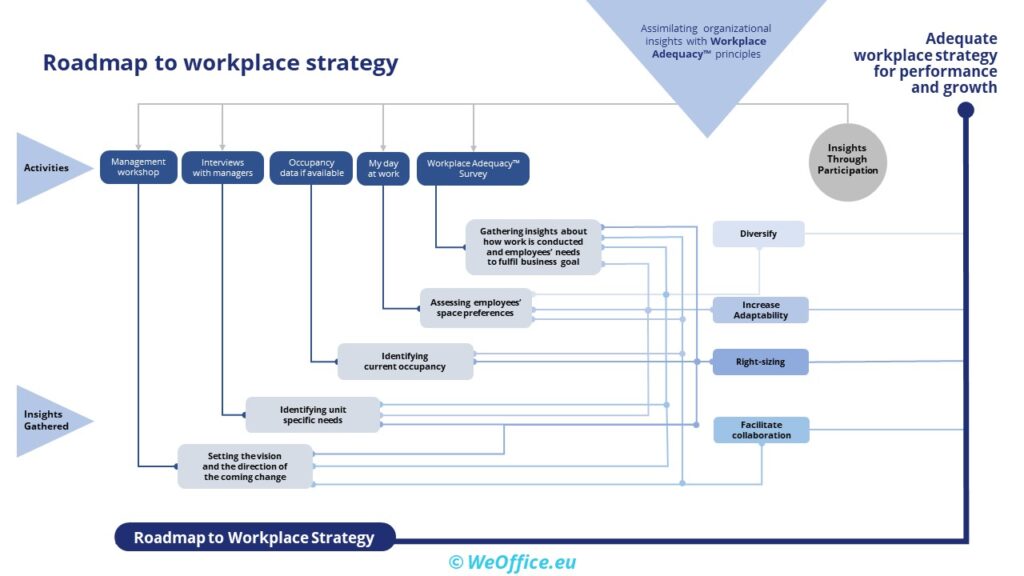
Workplace Adequacy™ Framework
The Workplace Adequacy™ framework builds on five research-based principles, proven tools (surveys, workshops and interview guides) and a structured methodology for developing a workplace strategy.
The framework is used to identify the organisation’s vision and its current conditions, as well as what demands the work places on employees. The methodology offers clear guidance on how to gather necessary data for developing a workplace strategy, along with how to interpret and implement it.
The Workplace Adequacy™ framework is used as the base of our Certified Workplace strategist education, and is provided by us at WeOffice. You can read more about the framework in the book “Workplace Strategy for the Flexible Office – Methods, tools and case studies with a focus on hybrid and activity-based ways of working”

The principles
Workplace Adequacy™ includes five research-based principles that were developed to give workplace strategists an understanding of which aspects are important to plan and stick to when developing a workplace strategy.
These principles are Right-sizing, Diversify, Facilitate Collaboration, Increase Adaptability and Insights Through Participation.
Right-sizing
This principle addresses the need for a workplace to be dimensioned for the correct number of people – not too few, to avoid crowding, or too many, to ensure space effectiveness and avoid the office feeling empty or desolate. In order to do so, you will need to know how many employees come into the office on an average day when many people are in. Right-sizing is a fundamental principle that is difficult to compensate for if it goes wrong, especially is the office is under-dimensioned.
Read more about right-sizing here.
Diversify
Diversifying the workplace means creating different types of spaces for different activities. Regardless of the degree of flexibility you wish to practise at the future office, all workplaces need to diversify. In traditional offices, diversification in its simplest form might mean creating meeting rooms and lunch areas alongside designated desks. In flexible workplaces such as activity-based offices, diversifying refers to creating a range of different spaces from work rooms to collaboration rooms, meeting rooms, desks in an open-plan, social areas and more. In order to diversify the office correctly, you need to pay attention both to what kind of physical environment is needed for the intended workplace and how many of each type of space is needed. One way to identify these needs is to utilise the Workplace Adequacy™ Survey and the ‘My day at work’ workshop. You can read more about diversifying here.
Facilitate Collaboration
A workplace should be a hub for meeting and interactions. But in order to bring on collaboration, certain fundamental needs must be fulfilled. Simply establishing a flexible way of working or seating people close to each other will typically not lead to the desired effects. You need to do more – something that is captured by this principle. Below, I will explain three aspects that provide organisations with their desired collaborations from a workplace strategy perspective.
Privacy – One fundamental part of collaboration is to ensure that the need for privacy is fulfilled. If it isn’t, people will try to distance themselves from interactions in one way or another. This could be mechanical, like by putting on headphones to make oneself unavailable. Another way to make oneself unavailable when privacy needs aren’t met is to move geographically, by going to another place or starting to work from home. A third way people can distance themselves is by cognitively trying to block out information, a mentally strenuous process that can lead to stress and tiredness.
Understanding the reason for collaboration – Another fundamental part of enabling strong collaborations is for the individual to understand the need for collaborating with others. Only talking about how increasing collaboration will benefit the business rarely leads to the desired effects; you need to clearly point out which parts of the business ought to increase their interaction, explain why it is important, and create organisational structures for realising the increased collaboration.
The digital and physical environments – Finally, both the physical space and the digital channels need to be designed in a way that makes it easy for co-workers to meet and work together.
You can read more about the Facilitate Collaboration principle here.
Increase Adaptability
This principle builds on the fact that we as humans have a harder time undertaking activities with higher hurdles. We like to take the easy route, even if a longer way would have been more beneficial. Therefore, we need to design the workplace in a way that makes the behaviours we desire the easiest choice to make. This could mean diversifying the workplace so that desirable workspaces are in close proximity to where employees are based, as well as making tech function seamlessly.
You can read more about Increase Adaptability (Mind nudges) here.
Insights Through Participation
This principle focuses on encouraging participation as an organisation works to develop a new workplace strategy. Not only is participation important for offering predictability in the process, it is also essential for effectively collecting reliable information about the needs of the workplace. The Workplace Adequacy™ framework de facto builds on systematically gathering important information through participation from the very start. The framework also includes methods and tools for collecting this data through employee participation, which I will go through below.
You can read more on the Insights Through Participation principle here.
The tools
The previous section has explained the principles an organisation needs to consider when developing a suitable workplace strategy. In order to address these principles, you will need a foundation that articulates the company vision moving forward, different groups or departments’ characteristics and special needs, guidelines for attendance at the workplace, the activities employees work on, the business’s mobility profile, and the collaboration that goes on between different groups.
No single tool or activity can capture all of these aspects alone. Therefore a variety of activities are needed to account for all bases.
Workshop with management
This workshop gathers the management team for the following parts:
- Vision for the new workplace – what do we want to achieve with the workplace strategy and what characterises the new workplace?
- Choosing the way of working – what level of flexibility should be practised at the workplace?
- Level of dimensioning – how well-dimensioned should the office be?
Focus group interviews with department managers
This activity captures department and unit-specific needs beyond the typical needs that are common at the workplace. Through semi-structured interviews, you can focus on each department’s characteristics and needs beyond what is associated with common work area types. This could be a need for archives, confidentiality, specific equipment and the like.
In our Certified Workplace strategist course we go through everything in detail with the questions you need answers for. You can find more information at Weoffice.eu.
Physical environment analysis
In this workshop, employees get the opportunity to point out their preferences for different types of workspaces for their different activities. The Workplace Adequacy™ physical environment analysis is known as My day at work.
Workplace Adequacy™ Survey
Surveys that are well-designed and validated allow you to effectively gather material from the entire organisation. The question areas included in the Workplace Adequacy™ Survey have been specifically developed to understand how the workplace functions and to undertake a needs analysis and development of a workplace strategy. There are different survey packages. Gather insights gives an analysis of what the workplace is like now and can be used to follow up on a change, Distinguish needs – development of a workplace strategy is used to establish a basis for developing a workplace strategy, and finally Lead the change establishes which aspects are important to understand in order to facilitate the journey to a new way of working. You can read more about the ‘Workplace Adequacy™ Survey’ here.
Attendance data
Gathering attendance data from entry systems is the most reliable way to dimension the office correctly. By collecting data from the system over a period of 60 to 90 days, you should get a good picture of what attendance is like from day to day, how much it varies and what the peaks are. Obtaining this data is rather easy and is indispensable for properly dimensioning the office.
Method
If the above principles are the appliances and utensils you’ll need to bake a cake, the tools are the ingredients that go into it. What remains is the knowledge of how to use the utensils and mix the ingredients to get a good result. The Workplace Adequacy™ framework offers this guidance. The framework also includes a process for collecting and analysing the data. It allows the workplace strategist to be guided by the organisation’s vision and its conditions, while being able to develop a strategy specific for the business based on the information gathered. You can find more information about how the method can be practised in the book “Workplace Strategy for the Flexible Office – Methods, tools and case studies with a focus on hybrid and activity-based ways of working”
About Dr Aram Seddigh
Dr Aram Seddigh (Ph.D) is a doctor in work and organisational psychology, a certified psychologist, and an economist. With ties to Stockholm University’s Stress Research Institute, he wrote his doctoral thesis on how different types of offices and ways of working affect employees’ health and productivity. Since then, he has worked as CEO and workplace strategist at WeOffice, where he also educates and certifies workplace strategists.
Read more about Aram Seddigh here.

Contact Us
Leave a Request and we'll contact you shortlyAlways be updated
Keep yourself updated by receiving our newsletter
 Connect with us
Connect with us
